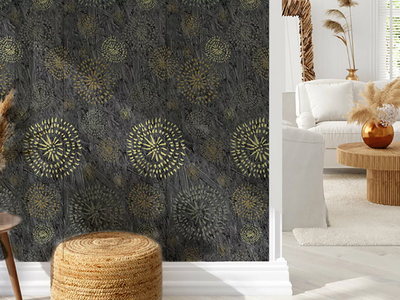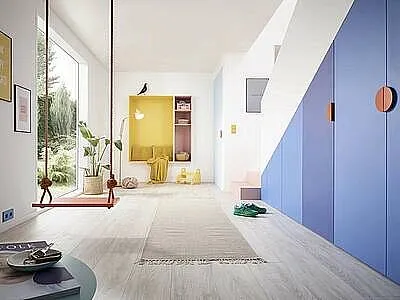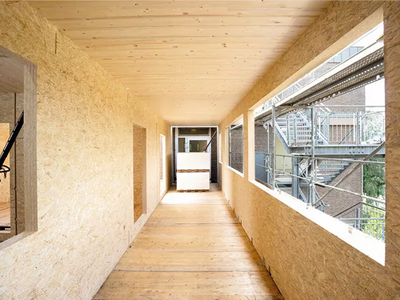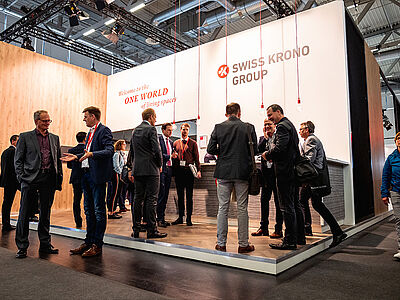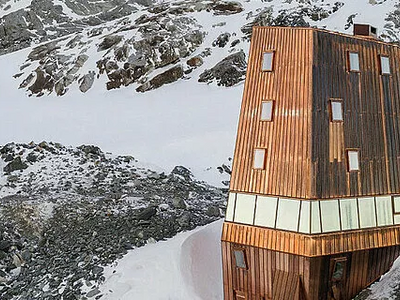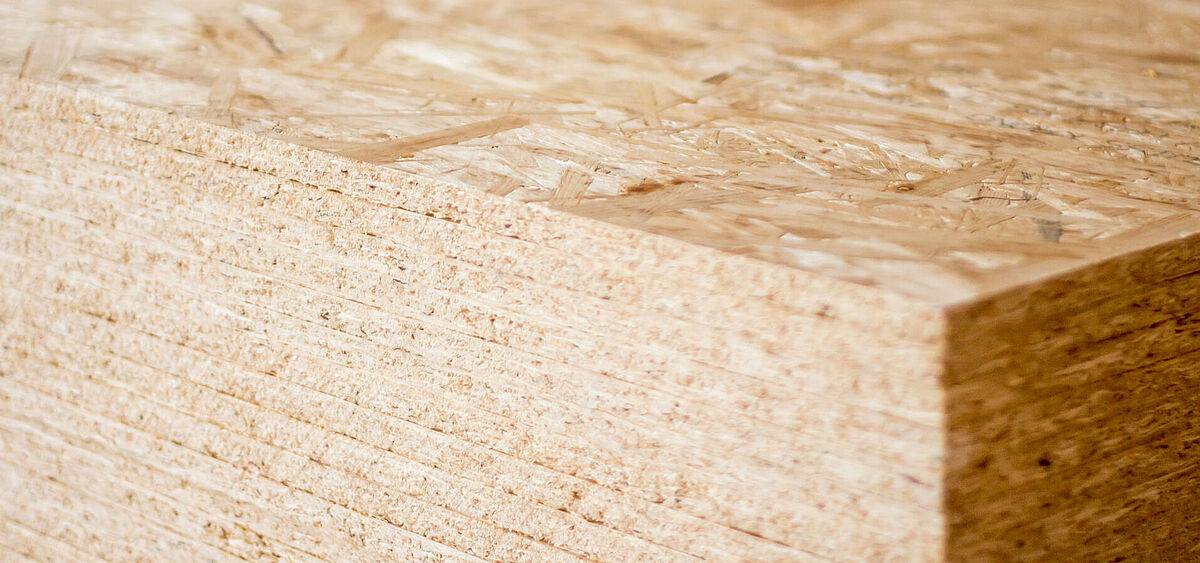OSB: Which Board Thickness Are Suitable for What?
OSB boards come in various grades, sizes and thicknesses. For example, SWISS KRONO supplies multifunctional engineered wood boards between nine and 40mm thick. But which thicknesses are appropriate for which applications?
Whether you need OSB products as loadbearing or reinforcing boarding on ceiling joists, in attics, as roof or wall panelling or as flooring, the right thickness depends on the application and the loads they must support. It’s also important to keep in mind that OSB boards are available in different grades and use classes. These define the applications for which a given board is suited and the maximum loads it can bear. For example, a thickness of only 12mm or 15mm may be enough when building a non-loadbearing interior wall.
The DIN EN 300 standard distinguishes four different OSB classes. Of these, classes 1 and 2 are not normally used in modern timber construction. In Germany, only classes 3 and 4 are available; these are suitable for both humid and dry conditions. Class 4 designates special heavy-duty boards for loadbearing applications.
If you only intend to use boards as cladding for visual effect, they can be relatively thin: a thickness of 18mm is adequate for non-loadbearing uses in dry conditions. If they are any thinner than that, there can be a risk of swelling and warping.
In Germany, both OSB/3 and OSB/4 are used for loadbearing purposes. Larger, thicker boards are more robust and able to withstand greater loads. So depending on where and how they are used, the recommended thickness can vary. While fairly thin boards are fine for wall cladding, constructive applications call for a correspondingly greater thickness with the required structural strength.
Thickness also matters when OSB needs to help protect against heat: thicker boards insulate better. This is because OSB has the same insulating properties as solid wood. What’s more, due to its greater density it has a larger storage volume. In these cases, however, it’s usually better to choose the greatest thickness with the required structural strength and then add thermal insulation.
For walls, it’s advisable to select boards that are as large as possible in order to minimise the number of joints. SWISS KRONO supplies special storey-high boards for this. In addition, SWISS KRONO produces special formats such as SWISS KRONO LONGBOARD OSB for jointless and therefore permanently airtight constructions up to 18m long.
Use in Ceilings and Floors
SWISS KRONO OSB is used in ceilings as loadbearing and reinforcing boards. Its high strength lets you keep panels relatively thin to reduce costs. SWISS KRONO OSB also makes a big contribution to optimising acoustic insulation and fire protection. When using OSB boards to cover ceilings or floors, tongue-and-groove joints are recommended because they facilitate installation and yield very even, level results. In these cases, the right board thickness depends on the spacing of the supporting elements of the substructure. Greater distances and loads require thicker boards. In the case of ceilings, boards between 18mm and 25mm thick usually deliver good results. Tables to aid in properly dimensioning SWISS KRONO OSB products are available on our website.
Use in Roofs
SWISS KRONO OSB is ideally suited as roof boarding. When using SWISS KRONO DP50 (water-vapour-permeable MD) as the underroof panelling, there’s no need to additionally attach membrane above the subroof space. Ideally, the inner boarding below it should be 15mm-thick tongue-and-groove SWISS KRONO OSB to ensure an airtight layer with low water vapour permeability. It’s also important to tape over the joints.
Current standards also permit SWISS KRONO OSB to be used as outer boarding in flat roof constructions. It can be sealed with bitumen or membrane and covered with zinc sheeting or slate roofing. Large rooftops can be realised much more quickly and easily this way than with conventional boarding. A minimum thickness of 22mm is recommended. Detailed information is available for downloading from our website.
Use in Walls
In timber-frame and timber-panel wall constructions, SWISS KRONO OSB excels as a reinforcing, water-vapour-inhibiting, airtight layer. The available storey-high formats minimise joints and trimming scrap. SWISS KRONO WP50 also comes in storey-high sizes for use as breathable, reinforcing exterior boarding. The recommended minimum thickness of OSB panels for timber-frame walls is 12mm when the cells in the supporting frame measure up to 62.5cm on a side, and 15mm for frame members spaced up to 83.3cm apart.
Overview of Normal Minimum Thicknesses for Different Uses:
- 9 + 10mm: packaging, protective panelling, furniture
- 12mm: water-vapour-inhibiting, airtight and reinforcing inner boarding in walls
- 15mm: inner boarding of walls and roofs to comply with the fire protection requirements of DIN 4102-4
- 18mm: loadbearing ceiling panels
- 22mm: loadbearing, reinforcing ceiling and roof panels
- 25mm: ceiling und roof panelling with widely spaced rafters and trusses and greater loads
- 30mm: panelling for fire resistance of 30 minutes based on the burn rates defined in DIN EN 1995-1-2
- 40mm: special applications involving heavily loaded constructions or enhanced fire protection requirements
By the Way ...
SWISS KRONO OSB engineered wood products are certified, perform excellently, pose no health hazards whatsoever and are even available in food safe versions. Despite this, false claims about OSB occasionally circulate, especially regarding how it differs from particleboard. The truth is that SWISS KRONO OSB is superior to conventional particleboard in all of the following respects:
- Wide range of uses
- Greater bending strength
- Greater loadability, also with thinner boards
- Lower weight per unit of volume, lower density
- Less binder used
- Completely formaldehyde-free bonding
- Made from PEFCTM-certified forest thinnings
- Usable for vapour control (eliminating the need for membranes)
You’ll find all of the relevant technical data and useful information on use on the following SWISS KRONO product pages:
- SWISS KRONO OSB/3 EN300, square-edge - ContiFinish®
- SWISS KRONO OSB/3 EN300, T+G – sanded on both sides
- SWISS KRONO OSB/3 EN300, T+G - ContiFinish®
- SWISS KRONO LONGBOARD OSB
- SWISS KRONO OSB/4 BAZ, sanded
- SWISS KRONO anti-termite, square-edge
- SWISS KRONO anti-termite, T+G
- SWISS KRONO kompaktholz, T+G - ContiFinish®
- QuicklyBoard OSB/3 EN300, square-edge - ContiFinish®
- SWISS KRONO OSB/F BAZ, square-edge - ContiFinish®
- SWISS KRONO OSB/F BAZ, T+G - ContiFinish®
- SWISS KRONO OSB/F BAZ LONGBOARD
This article contains more useful information: ”Finishing OSB: Valuable Information for Users”

